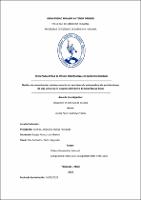| dc.contributor.advisor | Chávez Rimarachín, Manuel | |
| dc.contributor.author | Loyola Pérez, Katteryn Yadira | |
| dc.creator | Loyola Pérez, Katteryn Yadira | |
| dc.date.accessioned | 2023-09-15T21:24:29Z | |
| dc.date.available | 2023-09-15T21:24:29Z | |
| dc.date.issued | 2023 | |
| dc.identifier.uri | https://hdl.handle.net/20.500.12759/11176 | |
| dc.description.abstract | La restricción del crecimiento intrauterino representa una importante
morbimortalidad perinatal y cuya detección es variable según modelos clínicos y
características propias en cada población. OBJETIVO: Evaluar si el Doppler de arterias
uterinas y la edad materna conforman un modelo clínico con capacidad predictiva de
restricción del crecimiento intrauterino en una amplia muestra de población peruana.
MATERIALES Y MÉTODOS: Estudio observacional, analítico, de prueba diagnóstica.
Participaron 1344 gestantes atendidas en un centro de referencia nacional materno perinatal
Nivel III en Perú entre 2010-2018. La muestra fue seleccionada aleatoriamente y dividida en:
muestra de entrenamiento y muestra para validación del mejor modelo clínico obtenido. Se
usó análisis multivariado, medición de la capacidad diagnóstica y predictiva.
RESULTADOS: El modelo clínico formado por el índice de pulsatilidad promedio mayor al
percentil 95 de la arteria uterina y la edad materna mayor a 35 años conformo el modelo con
el menor indicador de penalidad de Akaike en comparación con los otros modelos clínicos
elaborados en el presente estudio, el índice de Youden fue 0.53. El área bajo la curva ROC
fue de 0.75. Se obtuvo una sensibilidad de 71.5%, especificidad 72.1%, valor predictivo
positivo 65.8%, valor predictivo negativo 91.2%. CONCLUSIONES: El uso del índice de
pulsatilidad promedio de la arteria uterina asociado a la edad materna contribuyen a la
formación de un modelo para discriminar RCIU; sin embargo, requiere de otros factores que
permitan ajustar el modelo para una mayor tasa de detección. | es_PE |
| dc.description.abstract | Intrauterine growth restriction represents an important perinatal
morbimortality and its detection varies according to clinical models and characteristics of
each population. OBJECTIVES: To evaluate if uterine artery Doppler and maternal age
conform a clinical model with predictive capacity of intrauterine growth restriction in a wide
sample of Peruvian population. MATERIALS AND METHOD: Observational, analytical,
diagnostic test study. A total of 1344 pregnant women attended a national maternal perinatal
reference center Level III in Peru between 2010-2018. The sample was randomly selected and
divided: training sample and validation sample. In the analysis, multivariate analysis and
measurement of diagnostic and predictive capabilities were applied. RESULTS: The clinical
model formed by the average pulsatility index greater than the 95th percentile of the uterine
artery and maternal age greater than 35 years made up the model with the lowest Akaike's
penalty indicator compared to the other clinical models developed in the present study,
Youden's index was 0.53. The area under the ROC curve 0.75. Sensitivity 71.5%, specificity
72.1%, positive predictive value 65.8%, negative predictive value 91.2%. CONCLUSIONS:
The use of the average pulsatility index of the uterine artery associated with maternal age
contributes to the formation of a model to discriminate IUGR; however, it requires other
factors to adjust the model for a higher detection rate. | en_US |
| dc.description.uri | Tesis | es_PE |
| dc.format | application/pdf | es_PE |
| dc.language.iso | spa | es_PE |
| dc.publisher | Universidad Privada Antenor Orrego | es_PE |
| dc.relation.ispartofseries | T_MED_3564 | |
| dc.rights | info:eu-repo/semantics/openAccess | es_PE |
| dc.rights.uri | https://creativecommons.org/licenses/by/4.0/ | es_PE |
| dc.source | Universidad Privada Antenor Orrego | es_PE |
| dc.source | Repositorio Institucional - UPAO | es_PE |
| dc.subject | Automedicación | es_PE |
| dc.subject | Infección de vías urinarias | es_PE |
| dc.title | Medios de comunicación masivo como factor asociado a la automedicación en infecciones de vías urinarias en usuarios del Centro de Salud Nuevo Rioja | es_PE |
| dc.type | info:eu-repo/semantics/bachelorThesis | es_PE |
| thesis.degree.level | Título Profesional | es_PE |
| thesis.degree.grantor | Universidad Privada Antenor Orrego. Facultad de Medicina Humana | es_PE |
| thesis.degree.name | Médico Cirujano | es_PE |
| thesis.degree.discipline | Medicina Humana | es_PE |
| dc.subject.ocde | https://purl.org/pe-repo/ocde/ford#3.02.27 | es_PE |
| renati.advisor.orcid | https://orcid.org/0000-0003-4786-1265 | es_PE |
| renati.author.dni | 72499028 | |
| renati.advisor.dni | 18162927 | |
| renati.type | https://purl.org/pe-repo/renati/type#tesis | es_PE |
| renati.level | https://purl.org/pe-repo/renati/level#tituloProfesional | es_PE |
| renati.discipline | 912016 | es_PE |
| renati.juror | Geldres, Alcántara Tomas Fernando | |
| renati.juror | Espejo Alayo, Luis Alberto | |
| renati.juror | Diaz Camacho, Pedro Segundo | |
| dc.publisher.country | PE | es_PE |




